Despite the fact that 2021 is not over yet, it has already set an interesting record. More than 1,400 satellites were launched into space in the first nine months. For comparison: for the whole of 2020, 1,300 spacecraft were launched outside the atmosphere, which, in turn, became a new record — before that, there had never been launched more than 1,000 satellites during one year.

The reason for these records is quite simple. SpaceX and OneWeb have embarked on very ambitious plans to deploy global satellite constellations. Their goal is to provide earthlings with the service of accessible satellite Internet.
Why do you need satellite internet?
Many metropolitan residents are likely to have a reasonable question about the fundamental demand for satellite Internet. Is not it a bit redundant? After all, fiber-optic technology allows you to achieve excellent connection characteristics at a very affordable price.
But the fact is that not all people live in large cities with high population density, where the laying of fiber-optic cable is economically feasible. Moreover, for the same economic reasons, in countries with a large territory, broadband Internet often remains a service available not in all regions. Even in the United States, millions of people are still forced to use an archaic dial-up connection. What then can be said about less rich countries? In many countries in Africa and Asia, the share of global network users does not exceed a few percent of the population.
This does not mean that the idea of using satellites to distribute the Internet in remote, sparsely populated or just poor parts of our planet is innovative. Such services have long been offered by a number of operators. But there are several reasons why satellite Internet has not yet become widespread. First, it is the price: to receive a satellite signal requires a rather cumbersome and quite expansive set of equipment. Secondly, the characteristics of the connection are far from ideal. Geostationary orbits are used to spread the Internet — so the satellites are hovering at the altitude of 36,000 km.

Of course, this makes sense, because a whole hemisphere is in the field of view of the satellite in the geostationary position. But such an arrangement also poses a significant problem due to the laws of physics. To reach the end user from such a distance, the signal takes much longer than when using the Internet from a terrestrial provider. This leads to a noticeable delay and ping (over 600 ms), which is very important for many programs and applications that are sensitive to signal delay (such as Skype), as well as for fans of network video games.
Therefore, until recently, satellite Internet was not seriously considered as a possible mass service. It was usually used only in the absence of any other available alternative. Due to the high cost and low quality of the connection, it could not compete even with broadband Internet, let alone access through fiber optics.
The second birth of satellite Internet
Of course, experts have long figured out how to improve the quality of the satellite signal: to place repeaters in lower orbits. This will significantly increase the data transfer rate and at the same time eliminate the associated delays. But the smooth operation of such a system requires many working devices to constantly keep the entire earth’s surface “in sight”. In turn, this requires a significant number of launches for the deployment and regular replacement of decommissioned satellites. High prices for launch services and the creation of space technology have made such projects economically unprofitable even at the stage of discussion.
But a few years ago, things started to change. As a starting point, we can single out 2013, when the US Federal Communications Commission (FCC) published a report on satellite Internet. The organization reported significant advances in communications technology that have significantly increased data rates from orbit. Soon, SpaceX began its victorious march into the launch market, which eventually led to a significant reduction in prices for commercial launches. To this was added a significant increase in the reliability of space technology with a tendency to reduce its cost. All this paved the way for the emergence of modern projects of mass satellite Internet.

In 2014, WorldVu, later renamed OneWeb, began developing an Internet access service system consisting of 700-900 spacecraft in a 1,200-kilometer orbit. Ironically, at that time the company maintained close contact with SpaceX. It is known that the founder of OneWeb Greg Wyler together with Elon Musk discussed the possibility of building a joint plant for mass production of satellites. However, the companies did not sign agreement, and soon their paths diverged. In January 2015, Elon Musk first spoke about plans to deploy a satellite group consisting of several thousand devices. The project was later renamed Starlink. At first, many experts were extremely skeptical of the billionaire’s words, considering them ordinary PR. But over time, it became clear that SpaceX was putting their money where their mouth was. In 2017, the company stirred up the public by asking the FCC for permission to place nearly 12,000 spacecraft in orbit (most recently, the company filed an additional application for more than 30,000 devices). A year later, it launched the first prototypes of Starlink satellites. Even then, many still could not believe in the seriousness of the company’s plans. It was hard to imagine that SpaceX really wanted to create a system that would require more satellites than had been launched in all 60 years of the space age.

But SpaceX once again managed to surprise everyone. In 2019, it showed the first batch of Starlink satellites placed under the fairing of the Falcon 9 rocket. It turned out that the company’s engineers carefully redesigned the devices, significantly reducing their size compared to earlier prototypes. This makes it possible to launch 60 satellites by a single rocket.
The process of global deployment of the Starlink constellation began in November 2019. Over the next two years, SpaceX launched 32 batches, totaling more than 1,700 satellites. In fact, the company managed to turn the process of their deployment into a real pipeline. No one in history has ever launched so many spacecraft in such a short period of time.
As for OneWeb, the company formalized its plans in the summer of 2015, signing a contract with Airbus Defense and Space for the production of 720 satellites. As a result of further adjustments, their number decreased to 640. The Soyuz-2.1 rocket was chosen as the main carrier. In February 2019, OneWeb sent six prototype satellites into space. The process of deploying the constellation began a year later. As of October 2021, it consists of 358 active devices.

In 2019, Amazon also officially joined the race for the creation of a global satellite Internet. The company announced the development of its own system called Kuiper — commemorating the famous astronomer Gerard Kuiper. In full deployment, this system will consist of 3,236 satellites launched into orbits at altitudes of 590, 610 and 630 km. It is expected that other devices will be launched using New Glenn rockets.
What about price
What does satellite internet look like? Contrary to popular belief, this is not about global free Wi-Fi from space, which can be easily accessed with a smartphone. Starlink satellites will transmit in the range from 12 to 18 GHz and from 26.5 to 40 GHz, OneWeb — at frequencies from 26.5 to 40 GHz. Wi-Fi-enabled devices use 2.4 and 5 GHz frequencies. A signal from space at this frequency simply will not penetrate the ionosphere. And even if it weren’t for this physical limitation, it would be somewhat naive to expect commercial companies to spend billions of dollars on such charity.
SpaceX began public testing of Starlink terminals in late 2020, now the equipment package can be purchased for $ 499, and the cost of a monthly subscription to communications services is $ 99. The transceiver is the size of a pizza box (diameter 61 cm, leg height about 50 cm) has a phase antenna array for satellite tracking. The terminal can be installed wherever it “sees” the satellites directly.

SpaceX currently provides Starlink services to more than 140,000 users in 20 countries. The average data rate is from 100 to 200 Mbps with a ping of about 20 ms. However, some users manage to achieve higher speeds — up to 340 Mbps. Considering the test results, the company has already decided to make changes to the shape of the antenna, reducing its size and weight.
As for OneWeb, in 2020 they announced that user terminals for shared access with a Wi-Fi distribution will cost from $ 1,000 to $ 1,500. However, this year the company’s management announced its intention to halve the price.
But what is the cost of deploying all these satellites? In 2018, SpaceX estimated it at $ 10 billion. However, it is not entirely clear whether this is a full version of the system or a version that can ensure its “economic viability”. According to other estimates, the overall cost could range from 20 to 30 billion dollars. This is a huge amount, but the company believes that the game is worth the candles. It is estimated that after full deployment, Starlink will bring in profits of up to $ 30 billion a year.
As for OneWeb, it will be much cheaper. The initial configuration of the system requires 640 satellites. According to some estimates, the cost of their development, construction and launch will amount to 2.6-3 billion dollars — quite a figure but still affordable. However, it can still change. It is known that the company’s management is studying the possibility of expanding the constellation, launching about 2,000 more devices in the future.

Another important difference between OneWeb and Starlink should be emphasized. The further is an ambitious, but still purely commercial project aimed solely at making a profit. Meanwhile, as for SpaceX, Starlink is not their “ultimate goal” at all. The main task of the company is to form a new market from scratch, which could provide it with regular demand for launches. According to Elon Mask, the proceeds from Starlink will go to the development and construction of the Starship spacecraft. In turn, this will allow the head of SpaceX to realize the dream of flying to Mars. By using Starlink services, you help humanity become an “interplanetary species.” Not a bad tag for an advertising campaign, is it?
Opponents of satellite Internet
All these ambitious plans can be thwarted not only by economic considerations, but also by the actions of opponents of the global Internet. Both Starlink and OneWebb have plenty of them. After SpaceX launched the first test batch of devices, numerous videos showing the “satellite procession” moving in the sky began to appear on the web. It turned out that Starlink spacecraft (at least for some time after orbit) are very bright objects that are clearly visible with the naked eye.

As a result, astronomers sounded the alarm. Many scientists have attacked SpaceX, accusing it of actually destroying the starry sky and making astronomical research impossible. In response, Elon Musk promised that the company’s experts will try to solve the problem of too high brightness of Starlink devices and make sure that the system does not interfere with ground-based observations. However, this did not convince everyone. Petitions calling to ban new Starlink launches quickly surged online.
After testing a number of methods (application of a special coating including), SpaceX was able to partly solve the problem by equipping the devices with special protective visors. This, as well as the change in the orientation of the solar panels at the time of entering the final orbit, has significantly reduced the brightness of the devices in the night sky.

Another serious challenge is space debris. Simultaneous launch of thousands of new devices will significantly increase the load on near-Earth space. Theoretically, the satellites that have stopped working will be quickly decommissioned. But, given their huge number, it is almost inevitable that some of them will suddenly crash and replenish the space debris population. A fully functional device can also be a source of problems. In recent months, Starlink has often been accused of dangerous flights near other satellites.
As a result, there are growing calls for a single “control” system for Earth orbits, which will prevent dangerous convergence by transferring individual satellites to safe “echelons”. But this will require the cooperation of all participants in the space market and the adoption of common standards for the use of orbits.
We should not forget about the Western antitrust authorities. If Starlink’s tariffs are indeed significantly lower than those of other suppliers, the company may well be accused of unfair competition, which could lead to years of litigation with unpredictable results.
But perhaps the most serious challenges for the global Internet can be created by the positions of individual states seeking to fully control their web traffic. The examples are easy to find. Back in 2019, the FSB said that OneWeb poses a threat to Russia’s national security (and this is despite the fact that Russian companies are actively involved in the creation of OneWeb satellites, and their launch into orbit is carried out using Russian missiles). And in the autumn of 2021 it became known that the country’s authorities have begun to prepare a law that provides for very significant fines on both legal entities and individuals for using satellite Internet.

At the same time it is necessary to understand that it is a question of a ban of the satellite Internet, instead of jamming of signals from orbit. Of course, this is possible in a certain area, but it is hardly possible on the scale of one ninth of the body of land. It is much easier for the authorities to ban the sale and operation of receivers, which will automatically block all legal work of corresponding companies in Russia.
Yes, if necessary, both Starlink and OneWeb can do without the Russian market. But it is very likely that similar problems will arise in other countries as well. Much will depend on China’s position. To get opportunity to operate in the huge Chinese market, Starlink and OneWeb will probably have to join the “Great Chinese Firewall”.
But it is much more likely that China will decide to act more radically deploying its own satellite Internet system to ensure full self-sufficiency — as it has already been done by creating a Beidou navigation system. This year, representatives of China have publicly announced plans to launch their own constellation of Internet satellites. Earlier, the Russian government has stated its readiness to join such a system to get a “safe” alternative to Starlink and OneWeb.
Unfortunately, in today’s world, the issue of affordable internet has not only an economic but also a very prominent political component. And as long as this is the case, it cannot be ruled out that we will end up in a rather sad situation where the Earth’s orbit will be filled with satellites of many global Internet systems that can operate exclusively within certain national boundaries. Although it is impossible to see state borders from orbit, unfortunately, this does not prevent people from using space to strengthen them.
